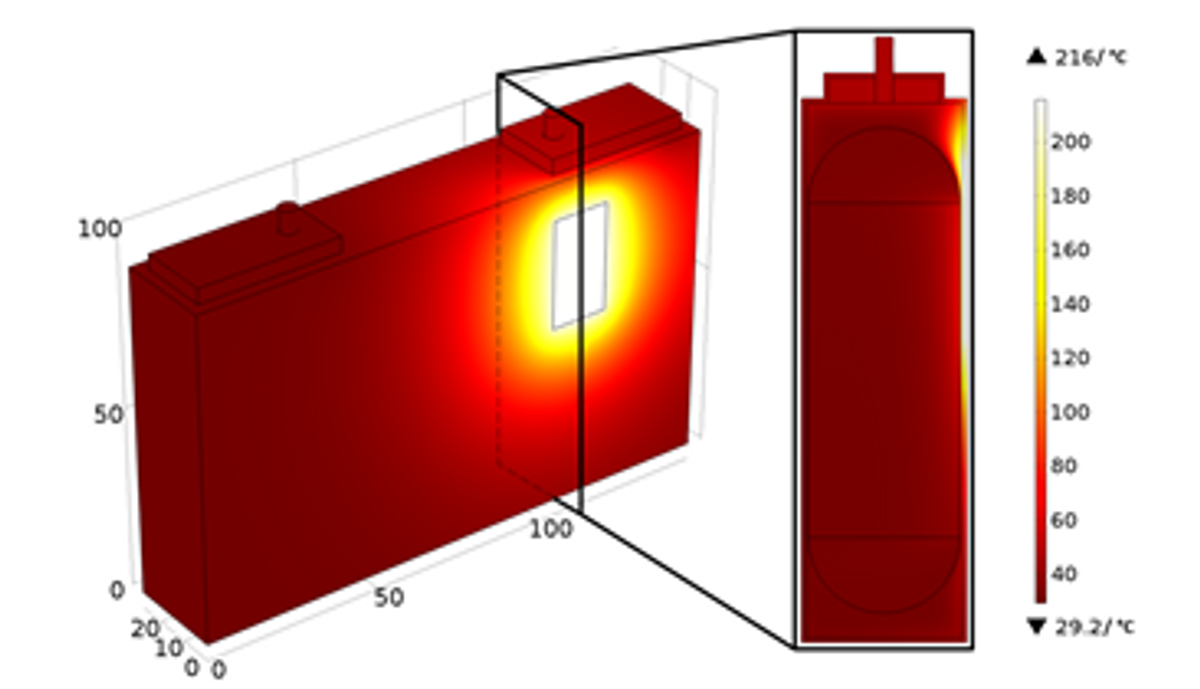The following is an excerpt from COMSOL News 2017.
By Jennifer Hand
The performance and durability of lithium-ion (Li-ion) batteries are heavily influenced by their operating temperature. Their performance decreases at low temperatures while the battery degrades quickly at high temperatures. This means that overall reliability is compromised, creating a potential safety issue.
Industry research has led to standards regulating the ability of a battery to withstand fluctuations in temperature when it is in operation. In contrast there has been much less focus on the temperatures that batteries are exposed to during the manufacturing process, which includes plasma pretreatment, UV curing, laser welding, ultrasonic joining, hot stacking, and hot gluing. A Li-ion battery may contain thousands of individual cells, which have to be stacked together. This is typically done through an assembling procedure that may involve various heat treatments, some of which can be extremely intense and expose the casing or other parts to high temperatures for short times.
Gerd Liebig of NEXT ENERGY EWE Research Centre for Energy Technology at the University of Oldenburg, Germany, explained, "It is already well known that certain processes such as welding greatly increase the temperature within a battery. What is not known is the extent to which such elevated temperatures could propagate within and compromise a cell."
Pamina Bohn from the University of Oldenburg and scientists from NEXT ENERGY set out in close collaboration to investigate whether it was possible for the manufacturing process to cause irreversible damage that would affect stability and capacity due to the onset of an electrochemical degradation process. As experiments can be lengthy and expensive with many safety precautions, the strategy was to validate their mathematical model. The research team used numerical simulation to investigate different operating scenarios and place probes to inspect results at any point in the model, which is impractical if not impossible during experiments.
Designing a Thermal Stress Experiment
The first step was to set up a physical experiment to measure temperatures reached inside a prismatic lithium dummy cell when it was subjected to short term thermal stress. The goal was to collect data that could be used to validate the mathematical model and investigate the effect of various processes during cell manufacturing. The cell consisted of a double-coated anode and a double-coated cathode surrounding a polyolefin separator, rolled up together. The rollup structure, known as the jelly roll, was soaked with organic solvents to mimic the battery electrolyte. Eight temperature sensors were placed on the cell: three in the middle of the jelly roll, three at the surface of the cell winding and two on the copper and aluminum current collectors of the anode and cathode, also known as arresters (Figure 1).
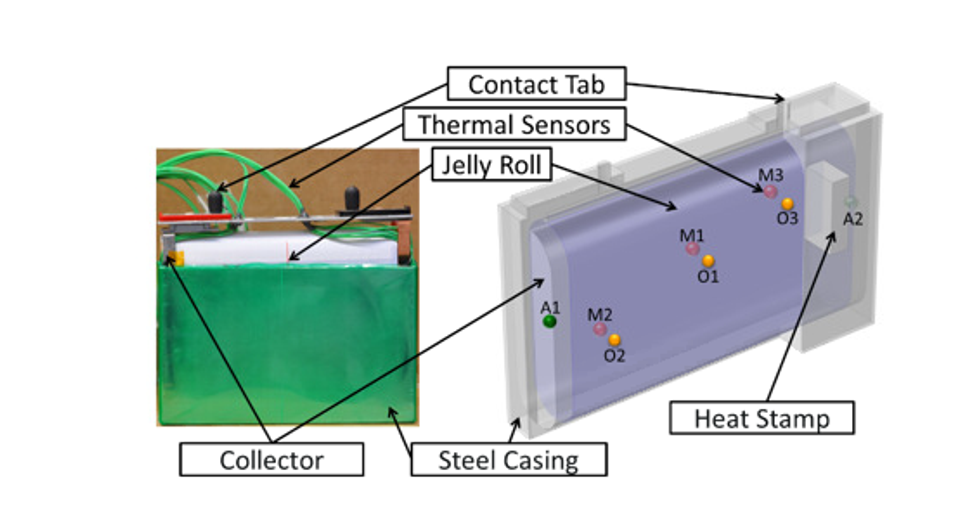
Modeling Thermal Behavior
The team also created a 3D replica of a commercial prismatic lithium cell in Autodesk® Inventor® software and imported this into the COMSOL Multiphysics® software. They modeled heat transfer by conduction due to an external heat source at different positions on the cell corresponding to different manufacturing processes, and the natural convective cooling on other areas of the cell surface.
The physical and thermal properties of the individual materials were experimentally defined and mathematically homogenized into one jelly roll domain within a prismatic steel housing. "Due to the anisotropic nature of the cell components, directional dependence of the thermal parameters needed to be considered in the model," comments Liebig.
In the simulation, a rectangular heat stamp was positioned as it had been for the physical experiment. Figure 2 shows the temperature distribution 60 s after the heat stamp is set on the cell surface. Adaptive mesh refinement was used to adopt a finer discretization in regions where temperature gradients were higher, ensuring high-accuracy results.
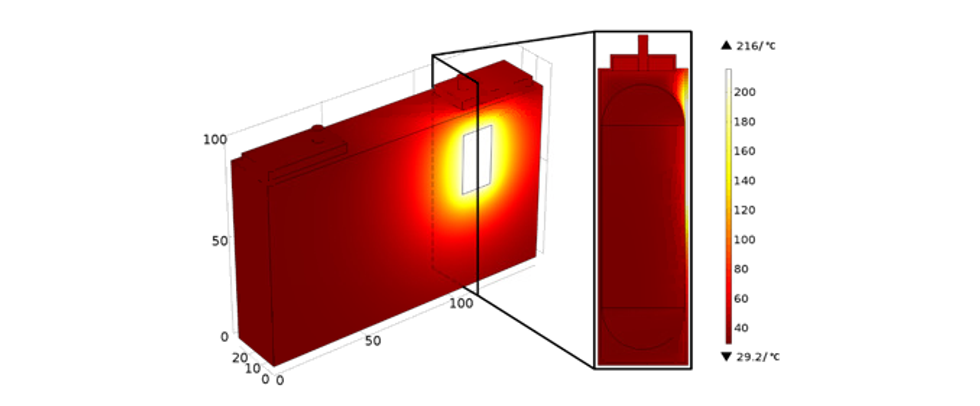
Looking for Signs of Damage
The multiphysics model came close to replicating the behavior of the dummy cell. After validating the model, team members were in a position to simulate temperature propagation within the cell during various manufacturing processes.
Figure 3 illustrates the distribution on the tab of the cell when a temperature load of 1100ºC, typical for welding, is applied for four seconds. Heat diffuses into the cell, causing temperature to rise above 100ºC. Even when the external heat source is removed the temperature within the cell continues to rise, reaching 138ºC in the jelly roll four seconds after the external heating has ended.
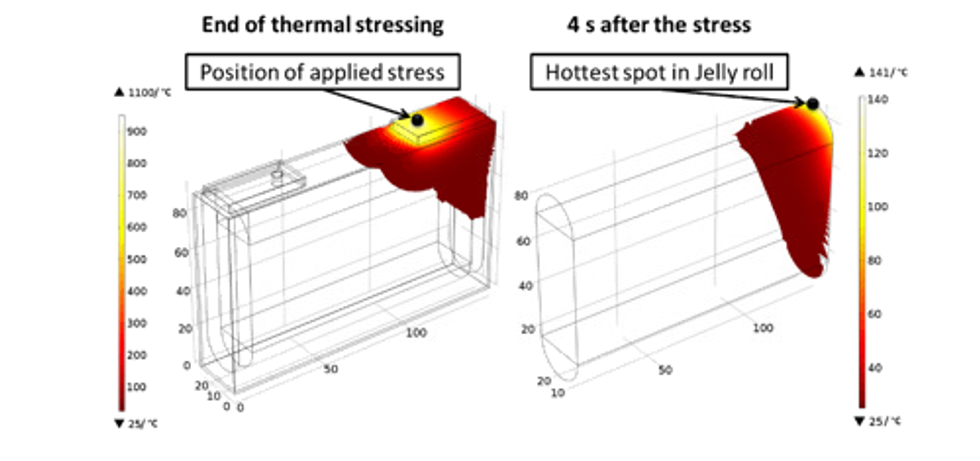
Bohn notes, "This temperature level will induce irreversible damages such as decomposition of the electrolyte, which is highly temperature sensitive, and changes to the characteristics of the solid-electrolyte interphase. These effects will cause not only local material damages, but also overall capacity losses and an increase in the cell resistance."
Delivering Power Without Damage
The researchers wanted to confirm that the high power density of a laser beam enables high welding rates yet limits heat input into the battery cell. This technique is very fast and due to the high power density of the beam, a large variety of metals can be used.
In order to simulate laser welding, a temperature of 1100ºC was applied on the cell tab for 0.2 seconds (Figure 4). The team determined that heat propagated along the cell housing, causing moderate temperatures which did not exceed 36ºC and were therefore not a danger to battery components. The simulated temperature distribution within the jelly roll is in good agreement with thermographic images taken several seconds after laser welding on a 26650 Li-ion cell.
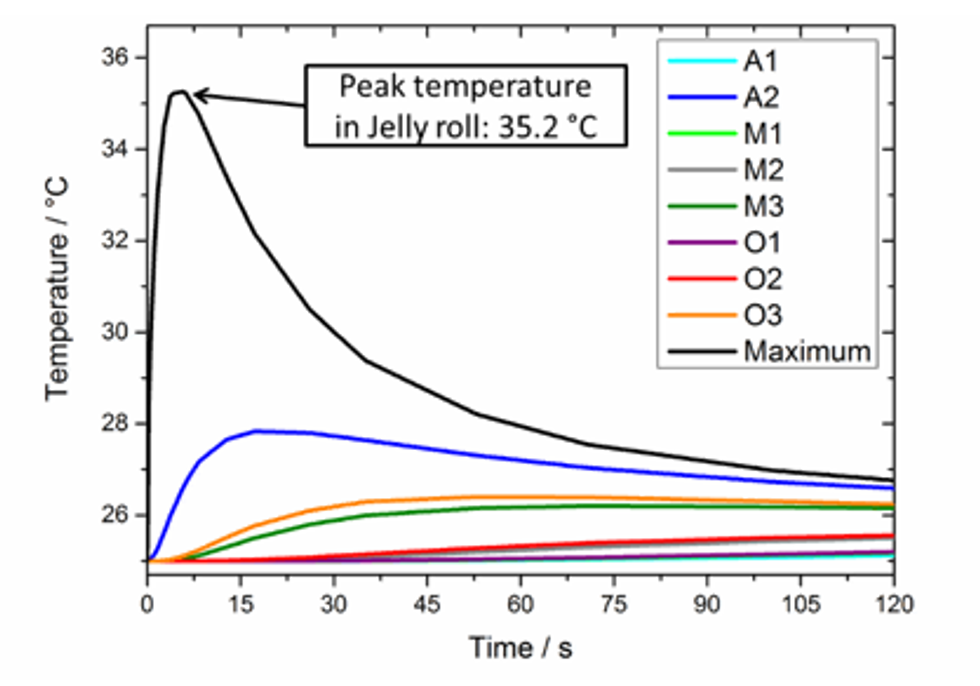
A Foundation for the Future
Liebig says, "We now have a trustworthy simulation tool. COMSOL Multiphysics is intuitive and provides helpful tools. It is so easy to adapt to our needs, from materials to boundary conditions. The different physics interfaces, geometry tools, and flexibility can save a tremendous amount of time."
The team concludes: "Because there are so many types of batteries for different applications, it is not possible to have one perfect material, size, or shape and our model provides huge scope for future research. We can vary the geometry, the application, and materials. Thanks to numerical simulation we can confidently continue investigating lithium batteries."
To read more about multiphysics simulation, click here.
